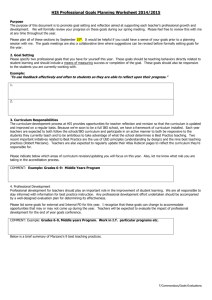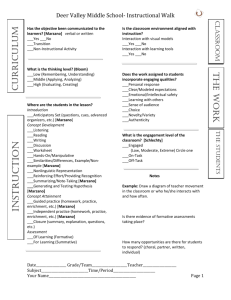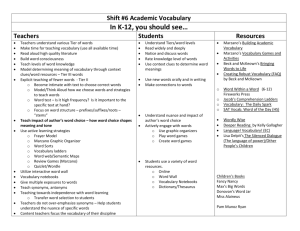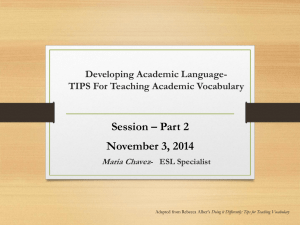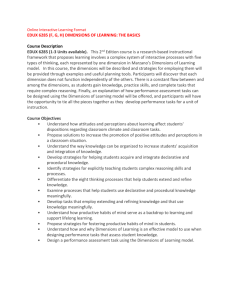Spaced vs. Massed Practice: In the Context of Learning by Jana L
advertisement
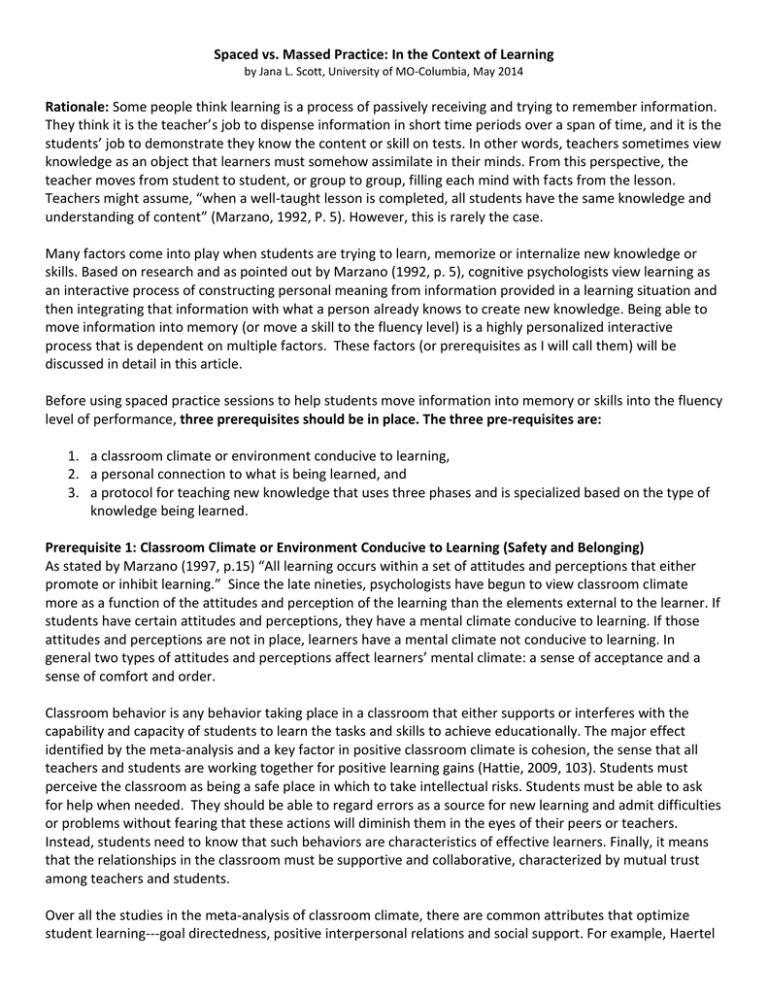
Spaced vs. Massed Practice: In the Context of Learning by Jana L. Scott, University of MO-Columbia, May 2014 Rationale: Some people think learning is a process of passively receiving and trying to remember information. They think it is the teacher’s job to dispense information in short time periods over a span of time, and it is the students’ job to demonstrate they know the content or skill on tests. In other words, teachers sometimes view knowledge as an object that learners must somehow assimilate in their minds. From this perspective, the teacher moves from student to student, or group to group, filling each mind with facts from the lesson. Teachers might assume, “when a well-taught lesson is completed, all students have the same knowledge and understanding of content” (Marzano, 1992, P. 5). However, this is rarely the case. Many factors come into play when students are trying to learn, memorize or internalize new knowledge or skills. Based on research and as pointed out by Marzano (1992, p. 5), cognitive psychologists view learning as an interactive process of constructing personal meaning from information provided in a learning situation and then integrating that information with what a person already knows to create new knowledge. Being able to move information into memory (or move a skill to the fluency level) is a highly personalized interactive process that is dependent on multiple factors. These factors (or prerequisites as I will call them) will be discussed in detail in this article. Before using spaced practice sessions to help students move information into memory or skills into the fluency level of performance, three prerequisites should be in place. The three pre-requisites are: 1. a classroom climate or environment conducive to learning, 2. a personal connection to what is being learned, and 3. a protocol for teaching new knowledge that uses three phases and is specialized based on the type of knowledge being learned. Prerequisite 1: Classroom Climate or Environment Conducive to Learning (Safety and Belonging) As stated by Marzano (1997, p.15) “All learning occurs within a set of attitudes and perceptions that either promote or inhibit learning.” Since the late nineties, psychologists have begun to view classroom climate more as a function of the attitudes and perception of the learning than the elements external to the learner. If students have certain attitudes and perceptions, they have a mental climate conducive to learning. If those attitudes and perceptions are not in place, learners have a mental climate not conducive to learning. In general two types of attitudes and perceptions affect learners’ mental climate: a sense of acceptance and a sense of comfort and order. Classroom behavior is any behavior taking place in a classroom that either supports or interferes with the capability and capacity of students to learn the tasks and skills to achieve educationally. The major effect identified by the meta-analysis and a key factor in positive classroom climate is cohesion, the sense that all teachers and students are working together for positive learning gains (Hattie, 2009, 103). Students must perceive the classroom as being a safe place in which to take intellectual risks. Students must be able to ask for help when needed. They should be able to regard errors as a source for new learning and admit difficulties or problems without fearing that these actions will diminish them in the eyes of their peers or teachers. Instead, students need to know that such behaviors are characteristics of effective learners. Finally, it means that the relationships in the classroom must be supportive and collaborative, characterized by mutual trust among teachers and students. Over all the studies in the meta-analysis of classroom climate, there are common attributes that optimize student learning---goal directedness, positive interpersonal relations and social support. For example, Haertel and Walberg (1980) found that learning outcomes were positively associated with cohesiveness, satisfaction, tasks difficulty, formality, goal direction, and material environment. They were negatively associated with friction, cliquishness, apathy, and disorganization. Johnson and Johnston (1987) found that cooperation among adults promoted achievement, positive interpersonal relationships, social support, and self-esteem. These findings were consistent across decades with no differences for individual or group rewards, in laboratory of field settings, by study duration, types of tasks involved, or quality of the study. Prerequisite 2: A Personal Connection to What is Being Learned (Relevance) The notion of a meaningful curriculum is not a new one. John Dewey (1990), writing in 1902, called for a curriculum that involves a critical but balanced understanding of the culture and the prior knowledge of each child in order to extend learning. According to Spillane (2000), presenting content in more authentic ways—disciplinary and other real-world contexts—has become a central theme of current reform movements. Schools should be places where “the work students are asked to do [is] work worth doing” (Darling-Hammond, 2006, p. 21). Research collected by the International Center for Leadership in Education shows that “students understand and retain knowledge best when they have applied it in a practical, relevant setting” (Daggett, 2005, p. 2). A skilled 21st century educator helps students master learning targets and standards using purposefully crafted lessons and teaches with appropriate instructional strategies incorporated. The students understand why they are learning particular skills and content and are engaged in learning opportunities that allow them to use their inquiry skills, creativity, and critical thinking to solve problems. According to Brown, Collins, and Duguid (1989), instruction connected to individual contexts has been found to have a significant impact on learning. Research conducted by Sanbonmatsu, Shavitt, and Sherman (1991) and Petty and Cacioppo (1984) contends that student learning is directly influenced by how well it is connected to a context. Much of this research began with the analysis of how people learn when they find the ideas significant to their own world and shows the importance of connecting content and instruction to the world of the students. Weaver and Cottrell (1988) point out that the manner in which content is presented can affect how students retain it. If students do not see any connection, it is difficult for them to move knowledge into memory. Instruction that connects the content to the students’ lives and experiences helps students gain meaning. Sass (1989) and Keller (1987) suggest that if teachers can make the content familiar to the students and link it to what they are familiar with, students’ learning will increase. Prerequisite 3: A Protocol for Teaching New Knowledge that Lays the Groundwork for PRACTICE sessions. Moving knowledge into memory or skills into the fluency level of performance involves much more that dispersing practice sessions into shorter time segments spread out over a span of time. Prior to having students PRACTICE, there are two prerequisite steps in the protocol for teaching new information that need to occur. The nature of these two prerequisite steps depends on the type of knowledge being learned. The prerequisite steps needed prior to practicing declarative knowledge look different than the prerequisite steps for practicing procedural knowledge. Bottom line, prior to jumping into practice sessions with students, make sure all the prerequisites are in place or the likelihood of moving knowledge into memory are slim to nothing. I will explain the difference between declarative knowledge and procedural knowledge so readers will have a greater understanding as to why the learning processes for declarative and procedural knowledge differs. Procedural vs. Declarative Knowledge (See Figure 1.1) Declarative knowledge involves understanding component parts and being able to recall or understand them. Declarative knowledge includes facts, concepts or generalizations (Marzano, 1997, pp. 33). Facts are the most basic type of declarative knowledge. They include basic undisputable facts. Concepts are more complex than facts. They usually one or two general words that are broad in meaning and sometimes are defined in more than one way. Generalizations are the most complex type of declarative knowledge. These are broad overarching statements that are usually arrived at as a result of reviewing several facts and drawing a conclusion about those facts. Generalizations may be proven logical or not logical by a careful review of facts. Examples: Facts: Kennedy was assassinated on November 22, 1963. Abraham Lincoln was the 16th president of the United States. Concepts: Revolution Social unrest Wealth Democracy Generalizations: “As a result of social unrest, revolutions occur.” “A lack of natural resources leads to an economy primarily based on services.” “For every action there is a reaction.” Procedural knowledge involves a set of steps, skills and processes. Procedural knowledge includes three basic types of procedures that might be taught in a content area class: algorithms, tactics or strategies. (Marzano, 1997, pp. 33 and 56) Algorithms are basic in nature and are a set of steps that guarantee a certain result. Such as a series of steps that result in a correct answer. Tactics are somewhat different. Tactics aid in the accomplishment of a goal but do not necessarily ensure it accomplishment. They involve general rules rather than a series of steps. For example, the general rules for reading a bar graph are more tactical than algorithmic. Strategies unlike algorithms and tactics are not specific to any one task. You would have a tactic of for a specific task of reading a bar graph, whereas you would have a general strategy for approaching problems of any type. (Marzano, 1997, p.56) Examples: Algorithms: 23 +24 = ____; ½ X 3= ____ ; Edit a sentence for spelling errors. Tactics: When adding three single digit numbers, try some of these tactical moves……Try to find two numbers whose sum equals ten, then add the third number to ten. OR Add the two smaller numbers first, then add the largest number. OR Make groups of tens and then add ones. Proofread a written paper for mechanical errors and determine effectiveness of voice and format. Strategies: To solve this problem I can plan backwards, make a chart, make a drawing, make a easier problem, etc. Design a research study to determine effectiveness of pesticides on crop rust. Figure 1.1 Learning Process for Procedural Knowledge: (See Figure 1.2) From Marzano, Robert, J. A Different Kind of Classroom: Teaching with the Dimensions of Learning. Alexandria VA, Association of Supervision and Curriculum Development, 1992. Phase 1: “The first phase of learning procedural knowledge is model building. The model looks differently for three basic types of procedures (skills, tactics, and strategies). The model for an algorithm would be a series of ordered steps. The model for a tactic would be a set of general rules or tactics for accomplishing a specific task. Such as a list of general rules for reading a bar graph. The model for a strategy would be a listing of general rules that may be applied to any problem or across content areas.” (Marzano, Robert J. 1992) Phase 2: “The second phase of learning procedural knowledge is shaping. This is the most important part and the part that develops the expertise in performing the skill. In this phase the learner tries to use the initial model provided to them by the teacher or constructed by himself. If needed, the student alters the model to work better. This is the phase in which systematic errors are commonly introduced so the student can become stronger at using the skill or process. Common strategies for shaping include: guided practice and scaffold instruction.” (Marzano, Robert J. 1992) Phase 3: “The final phase of learning procedural knowledge is to internalize knowledge to the point a person can perform it fluently or with relative ease. This is where spaced vs. massed practice comes into play. The practice sessions of the skill should be extended into several short sessions as opposed to a few large sessions. It is most accurate to think of performing skills and processes on continuum of skill levels from controlled processing to automaticity. Algorithms are commonly learned to the point of automaticity and can be done without conscious thought such as driving a car or language. A controlled process on the other hand requires conscious thought even when perfected. For example the strategies required in doing advanced problem solving of non-routine real world problems require conscious thought. Regardless of whether a process is learned to the level of automaticity or the level of expert control, it is extended practice that gets the learner to where he or she needs to be.” (Marzano, Robert J. 1992) Figure 1.2 Learning Process for Declarative Knowledge: (See Figure 1.2) Phase 1: “The first phase of learning and remembering declarative knowledge is constructing meaning and involves helping learners access what they already know about information. Constructing meaning using prior knowledge is a vital component of learning declarative knowledge. A number of strategies can facilitate this process. The most popular strategies is a KWL. Concept formation is another powerful strategy. Strategies used to help students construct meaning from declarative knowledge are numerous and varied….others include brainstorming, reciprocal teaching, analogizing and semantic webbing.” (Marzano, Robert J. 1992) Phase 2: “The second phase of learning and placing declarative information into memory is organizing information or creating our own internal representation of information. At a very basic level, organizing means representing information in a very subjective, concise way. It involves identifying what is important and what is not important and then generating a semantic or symbolic representation of that information. Information should be recorded in large general chunks rather than small specific pieces of information. For example instead of focusing on specifics, it is better to focus on general information.” (Marzano, Robert J. 1992) Phase 3: “The third phase of learning declarative knowledge is storing information into memory. This part would be unnecessary if learners did not have to remember information over an extended period of time. Based on the results of research extended over many years, the elaboration strategies far surpass verbal rehearsal strategies for remembering information. The most powerful elaboration strategies are to associate mental pictures, physical sensations, and emotions with the information to be memorized. Many formal memory systems use imagery as an elaboration tool for remembering. The learner creates a mental image for each piece of information he wants to recall, making sure to create vivid patterns by imagining sounds, tastes, smells, and so on. Then link the images in story fashion.” (Marzano, Robert J. 1992) In Summary: Moving knowledge into memory or moving skills/processes towards fluency involves much more than just spacing out practice sessions over a time span. Prior to beginning any type of practice, three prerequisites should be in place. 1) a classroom climate or environment conducive to learning; 2) a personal connection to what is being learned, and 3) a protocol for teaching a new knowledge that uses three phases and is specialized based on the type of knowledge being learned. (See Figure 1.3) Figure 1.3: Focus Questions: Prior to setting up practice sessions for students ask yourself the question below to ensure you have addressed the prerequisite skills needed for spaced practice of moving knowledge into memory or moving skills towards fluency. Focus Questions for Prerequisites Before Practice Prerequisite 1: Classroom Climate or Learning Environment 1. How do I ensure all my students feel as if they are accepted by their classmates? 2. How do I ensure my students feel the classroom is a comfortable place to be? 3. How do I ensure all of my students feel physically safe in my classroom? 4. How do I ensure all of my students feel mentally/physiologically safe in my classroom? 5. How do I help my students feel comfortable enough to ask for help when needed? 6. How do I help my students regard errors as a source for new learning? 7. How do I help my students admit difficulties without fearing that these actions will diminish them in the eyes of their peers or me? 8. How do I promote relationships in my classroom that are supportive and collaborative in nature? 9. How do I create a sense of mutual trust among me and all my students? 10. What ways do I ensure my directions and procedures clear, and that all students know them? 11. What ways do I ensure transitions between my activities are orderly? 12. How to I specify learning targets and success criteria, and ensure both are understood by all students? Prerequisite 2: Personal Connection 1. When designing curriculum, lessons, activities, how do I take culture and prior knowledge into consideration? 2. What percentage of my activities and assessments require application in the real-world or by using a scenario to describe a real-world context? 3. How do I share with students ways particular skills and content relate to real-world contexts? 4. How are my students engaged in learning opportunities that allow them to use their inquiry skills, creativity, and critical thinking to solve real-world problems or address real-world issues? 5. What ways do I connect academic content and instruction to the world of my students? 6. What ways do I integrate across disciplines to show connectedness among various content areas? Prerequisite 3: Protocol for Teaching New Knowledge 1. Prior to jumping into practice sessions with students, do I do steps 2-3 below? 2. How do I determine which type of knowledge the students are going to learn so I will know which learning process the students will use to learn new information? 3. How do I choose the proper (three phase) learning process based on the type of knowledge the students are trying to learn? 4. How do I guide students through Phase1and Phase 2 of the learning process prior to having them move into the third phase or practice phase of learning? Resources De Corte E. Acquiring and teaching cognitive skills: a state-of-the-art of theory and research. In: Drenth PJ, Sergeant JA, Takens J, editors. European Perspectives in Psychology, Vol 1. London: John Wiley; 1990. pp. 237– 63. Dochy FJRC. Assessment of Prior Knowledge as a Determinant for Future Learning: The use of prior knowledge state tests and knowledge profiles. Utrecht/London: Lemma BV; 1992. pp. 43–72. Dochy FJRC, Segers M, Buehl MM. The relation between assessment practices and outcomes of studies: The case of research on prior knowledge. Rev Educ Res. 1999; 69:145–86. Donald JG. Learning to Think: Disciplinary Perspectives. San Fransisco: Jossey-Bass; 1968. p. 71. Excellence and Enjoyment: learning and teaching in the primary years. Creating a learning culture: conditions for learning Primary National Strategy | DfES 0523-2004 G | © Crown copyright 2004 http://www.lancsngfl.ac.uk/curriculum/assessment/download/file/10%20Learning%20Environment.pdf Hattie, John. Visible Learning: A Synthesis of over 800 Meta-Analysis Relating to Achievement. London: Routledge, 2009. Keller, J. M. (1987). Strategies for stimulating the motivation to learn. Performance & Instruction, 26(8), 1–7. Marzano, Robert, J. A Different Kind of Classroom: Teaching with the Dimensions of Learning. Alexandria VA, Association of Supervision and Curriculum Development, 1992. Marzano, R.J. A New Era of School Reform: Going where the research takes us. Aurora CO: Mid-Continent Regional Educational Lab, 2000. Scott, Jana L. Spaced Practice: In the Context of Learning, University of MO-Columbia, 2014. Sprenger, Marilee. How to Teach Students to Remember. Alexandria VA, Association of Supervision and Curriculum Development, 2005. Tobias S. Interest, prior knowledge, and learning. Rev Educ Res. 1994;64:37–54. Weeks K, Lyne P, Torrance C. Written drug dosage errors made by students: the threat to clinical effectiveness and the need for a new approach. Clin Effectiveness Nurs. 2000;4:20–9.
